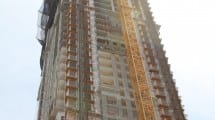

Christopher J. Russo check out windows at a construction site in the City. (Photo by Leah Einwalter)
Living in Sunny Isles Beach is typically associated with being in paradise. Residents and visitors alike comment on the beautiful water, our parks, the weather, and notably, the unique and beautiful architecture of this modern state-of-the-art city, which has risen over the past sixteen years to truly be “Florida’s Riviera.” Living through the construction to achieve the renaissance in our City is a necessary accommodation, a balance for what is in the best interest of the City over all. You may have noticed we are in another building boom. There are eleven projects approved and in some phase of construction. At least eight more projects are being contemplated. Approximately ten construction cranes are up in the City. Between 2000-2005, the height of the last building boom, we had twenty-five development projects either approved or under construction. Although we do not expect to see that level of activity again, we must endure construction.
The type of construction projects discussed in this article are complex developments that take up to three years to complete and involve the most sophisticated construction techniques. Some examples; large support piles may need to be driven 100 – 160 feet below grade, 12,000 cubic yards of concrete may need to be poured continuously for up to seventy-two hours in order to have the proper foundation to support a high rise. Then as these buildings rise, so do cranes that are used to lift materials 500 – 700 feet into the air. In order to achieve those heights, every so often sections need to be added to the crane in order for it to rise hundreds of feet. This process is called “jumps.” The process to add a section to a crane, which happens steadily during construction, is nothing short of an engineering marvel. It takes skill and extreme safety precautions to conduct this seemingly routine process. As a safety precaution, this process is usually conducted when no other construction activity is taking place on the site, and when wind conditions are acceptable.
There is also the need to connect the new construction to the public utilities, usually located in the street right-of-way. There are at least three aspects of public utility connection which are made at different times during the construction process. These are underground connections and usually require one to two lanes of traffic to be disrupted or closed to accomplish the underground work. Depending on the depth, length and types of connections being made, it can take weeks and possibly months to properly and safely excavate and install the equipment, conduits, wiring, or pipes involved. This work is mainly for the installation of the potable water lines, sanitary sewer pipes, storm drainage system, or electrical service and telecommunication equipment and wiring. This is a requirement of the city as part of its Beautification and Streetscape Plan.
At this point, you may be asking what can the city government do to ease the effects of all this necessary work. Well, there are a number of things we do to facilitate this work with the least disruption to traffic and residents. We are not the only community faced with this challenge, any desirable place to live and visit has gone through the same development issues and circumstances. In other words, this is the price for success!
There are steps that our City, along with many others, follow to lessen the effects of construction activity. Our city, like most governments, has noise and construction ordinances. These ordinances regulate work on weekdays and weekends. As much as we deem reasonable and appropriate, we will extend those hours for routine work either to begin earlier or last longer in the afternoon. Simply put, the more we are able to allow them to work, the faster the project is completed.
Much of the type of work I mentioned earlier in this article is not routine. Let’s start with the sizable utilities that need to be installed for each of their developments which will potentially house hundreds of people. As previously stated, these connections start from the site of construction and can extend along the public roadway for up to hundred(s) of feet. These connections have the potential of closing up to two lanes of traffic in order to actually excavate and have a proper and safe area to work from along the roadway. Florida Department of Transportation (FDOT) requires this work to be conducted overnight, basically between 9 p.m. and 5 a.m.
The crane extension, or jumps as they are known, is preferred to be done outside of high levels of activity on the site and surrounding area, and with proper wind speed conditions. This is clearly for safety considerations. This type of activity takes place on a weekend day or possibly in early morning on weekdays depending upon the amount of daylight available.
Deliveries of bulky items may be allowed during extended hours due to the nature of the delivery. For example, if all the windows for a 500 feet high rise were arriving, we would want that to happen outside of the most congested timeframes and when the site is free of full construction activity so this material can safely be unloaded and placed in an appropriate location on the site. Same is true for steel and other voluminous materials.
Large concrete foundation pours are typically scheduled beginning on a Friday night or Saturday and extending through the weekend for the required continuous pour, as I explained earlier. This particularly critical part of any construction project is weather dependent and subject to other factors that neither the City nor developer may have total control over.
However, for all of the items I have just attempted to explain, the city, through the applicable departments, conducts a review of all requests for extended hours. The results of these reviews may place certain restrictions for approval. Depending on size of the project and length of the requested extended hours, the city may require the developer assign an on-site representative to provide immediate attention to any complaints. One or more police officers may be required, at the developer’s expense, to control either traffic lane closures or access to the site to control large deliveries and other activities.
The Police Department will require a detailed plan from the developer for concrete trucks to follow as to their travel routes through the city. This is in order to create the most efficient circulation of these large trucks over our roads. Lastly, but most importantly, the City always retains the right at any time to deny or cancel a previously approved request to extend construction hours for any purpose.
I do hope this article at least helps to explain why we allow extended construction hours, seemingly “around the clock” as some have said, but in essence every request is taken on a case by case basis, and safety of the construction site and the residents and visitors that may be in the vicinity is our primary consideration. Second priority is aiding in the speedy conclusion of the construction process that has, and will continue to impact our vibrant and extremely desirable city.








